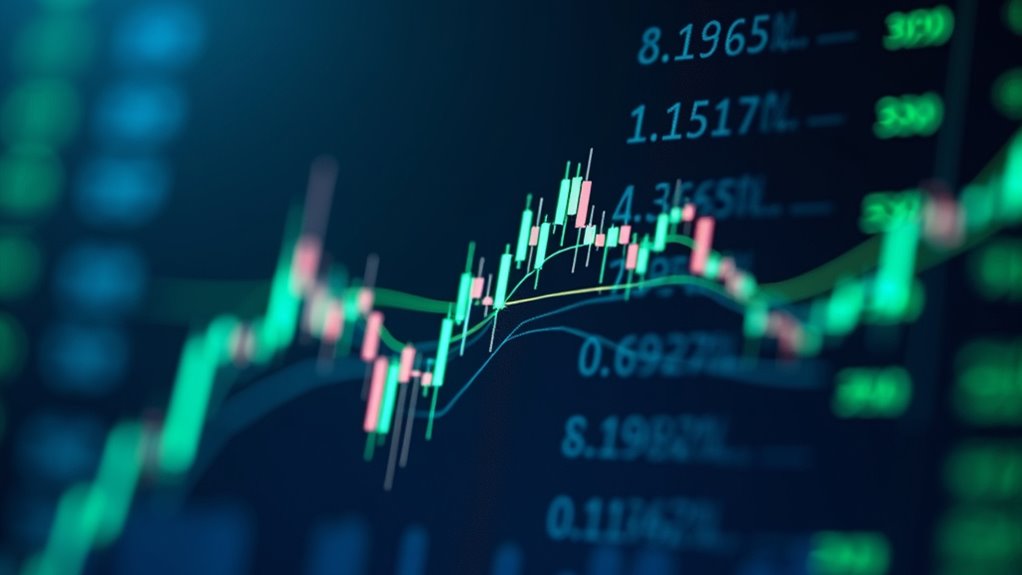A pip measures forex price moves—0.0001 for EUR/USD (e.g., 1.1050→1.1051), 0.01 for JPY pairs like USD/JPY due to yen’s low value. It standardizes profit/loss: a 10-pip EUR/USD swing means ±$100 per 100k-unit lot. Pips anchor risk management—a 50-pip stop-loss limits losses—and quantify spreads (costs). With USD/JPY’s 60–100 daily pip volatility, grasping these $8.33 (at ¥120.00) shifts enables precise strategy tuning.
Definition and Measurement of Forex Trading Pips
In forex trading, a pip—denoted as a “percentage in point”—measures the smallest price movement a currency pair can make. Most pairs, like EUR/USD, use four decimal places, with one pip equaling 0.0001.
However, Japanese yen-based pairs (e.g., USD/JPY) quote pips at the second decimal (0.01).
Pipettes, fractional pips equaling 1/10th of a standard pip, refine pricing to a fifth decimal (0.00001) for most pairs or a third (0.001) for JPY pairs, offering precise exchange rate tracking between bid and ask spreads.
This standardization lets you quantify shifts unambiguously: moving from 1.1050 to 1.1051 in EUR/USD represents one point or price interest unit. Brokers universally apply this convention to clarify profit/loss calculations across instruments.
Calculating the Value of a Pip Across Currency Pairs
You’ll see not all pips have equal value—they’re determined by the pair’s quote currency and pip increment.
For USD-based pairs like EUR/USD (where USD is quoted), a 0.0001 move equals $10 per standard lot, but with JPY pairs like USD/JPY (quoted in yen), one pip is 0.01, valuing each pip at approximately ¥1,000 or $9.09 if USD/JPY trades at 110.00.
Pips for non-USD crosses require conversions—for example,GBP0.8600 valuing each pip at £11.63 for a €100,000 EUR/GBP trade.
Different Pair Pip Values
A forex trader encounters differing pip values across currency pairs because their calculations depend on quote conventions each pair follows. For USD-quoted pairs like EUR/USD, your pip value is $10 per standard lot (100,000 units), as USD is the quote currency.
JPY pairs such as USD/JPY define a pip as 0.01, requiring a formula: multiply the pip size (0.01) by your trade size, then divide by the exchange rate. At USD/JPY 106.00, one standard lot earns $9.42 per pip movement.
Cross-currency pairs like EUR/GBP involve converting to USD terms—use (0.0001 × trade size) ÷ GBP/USD’s rate.
In volatile USD/TRY trades, expect pip values reaching $18-$22 for standard lots due to extreme spreads and low liquidity, emphasizing risk awareness.
Currency Pair Calculations
Calculating pip value accurately depends on a currency pair’s structure, and it’s fundamental for precise profit/loss assessment. You’ll calculate pip value differently if USD is the quote currency (e.g., EUR/USD) versus the base currency (e.g., USD/JPY).
For USD-quoted pairs like EUR/USD, pip value is $0.0001 per unit traded, resulting in $10/pip for 100,000-unit lot sizes (standard lots).
When USD is the base currency, apply the formula: (0.01 JPY / exchange rate) × lot size—USD/JPY at 150.00 yields ¥6,666 per lot (≈$6.67 based on USD/JPY rate).
JPY-based pairs uniquely define one pip as 0.01 due to the yen’s low unit value.
For cross-pairs like EUR/GBP, convert pip values into your account currency using prevailing exchange rates.
Exotics like USD/TR often require frequent recalculation due to exchange rate volatility.
Understanding Fractional Pips and Pipettes
How precisely do brokers quantify minuscule forex price shifts beyond standard pips? They use fractional pips—or pipettes (1/10th of a pip)—represented as superscript digits after the decimal point. For example:
- EUR/USD pipettes equal 0.00001, appearing as the fifth decimal place (1.10550)
- USD/JPY pipettes equal 0.001, shown as the third decimal (112.025)
Platforms display these extra decimal places to track ultra-precise pricing, essential for scalpers analyzing minor price movements. If EUR/USD shifts from 1.10550 to 1.10551, that’s one pipette; similarly, USD/JPY moving from 112.025 to 112.026 reflects a single pipette change.
Though helpful for granular trade execution, pipettes rarely impact profit/loss calculations directly—most forex traders convert them to standard pips (50 pipettes = 5 pips). Their core function is refining entry and exit accuracy in volatile currency pairs.
How Pips Determine Profit and Loss in Trades
Precision underlies every forex profit/loss calculation, where trades live or die by pip movements. When you trade Forex, your profit or loss hinges on multiplying the pip move by your position’s pip value—the monetary change per one-pip shift.
This value fluctuates across currency pairs due to exchange rates and lot sizes (predefined contract units).
- Standard lot trades: Gain 50 pips on EUR/USD (100,000 units) using a $10-per-pip value for $500 profit.
- Mini lot losses: Drop 30 pips in USD/CAD (10,000 units) at $1 per pip for a $30 loss.
- Scalping micro lots: Target 5-pip moves on 1,000-unit GBP/USD trades to earn $5 before spreads.
- Risk management: A 50-pip stop-loss caps losses at €500 in €100,000 EUR/GBP positions where pip values are €10.
Understand these mechanics to objectively predict outcomes.
JPY Exception: Special Considerations for Yen Pairs
While most currency pairs measure pip movements in increments of 0.0001, yen-denominated pairs like USD/JPY define a pip as a 0.01 price shift. This two-decimal convention (rather than four) for JPY currency pairs stems from the yen’s historically lower value per unit—you’ll track USD/JPY pips as whole-number changes (e.g., 150.00 to 150.01).
Pip values scale inversely with the rate; at USD/JPY 150.00, one pip for a standard lot equals ¥10,000 (100,000 units × 0.01).
Pipettes (fractional pips) appear as the third decimal (0.001), refining pricing precision: USD/JPY 130.415 versus 130.425 represents a one-pip difference.
Since profits/losses in JPY pairs generate yen-denominated values, you’ll convert these to your base currency (divide ¥ gains by the USD/JPY rate).
Note USD/JPY’s higher volatility—60–100 daily pips versus EUR/USD’s 70–80—amplifies pip impact.
Real-World Examples of Pip Impact on Forex Positions
You’ll see how pip movements convert directly into profits or losses: a 50-pip EUR/USD move on a standard lot yields $500, driven by its $10-per-pip value.
Position sizes amplify pip impacts—a 2,000-pip USD/TRY swing turns a micro-lot position into a $200 gain despite each pip’s low value.
These real-world trades demonstrate the critical relationship between pip values (the profit/loss per pip) and trade scale.
Profit Per Pip
Calculating your exact profit per pip bridges textbook concepts and real trading outcomes. You determine gains and losses by multiplying the pip change by the value of a pip, which varies by currency pair and trade size.
Since most pairs use four decimal places, one pip equals 0.0001 (or 0.01 for JPY pairs). The value of a pip depends on your trade’s standard unit volume:
- EUR/USD standard lot (100,000 units): Earn $10 per pip. A 100-pip rise from 1.1050 to 1.1150 yields $1,000.
- USD/JPY mini lot (10,000 units): Gain ¥100 per pip; a 50-pip move converts to $50 profit if USD/JPY is 100.00.
- GBP/USD micro lot (1,000 units): Lose $0.10 per pip; a 25-pip drop costs $2.50.
- Daily scalping (5 pips): Capture $0.50 daily with USD/CHF micro lots, compounding to $100 monthly.
Large Trade Impact
(Word count: 124)
Pip Value Conversions for Different Account Currencies
Managing pip values across various account currencies requires understanding how exchange rates affect conversions. When trading Forex pairs, you’ll calculate the pip value in your account currency using relevant exchange rates—brokers automate this, but manual checks verify accuracy.
- EUR-based account trading EUR/USD: Multiply a $10 standard lot pip value by EUR/USD rate (e.g., 0.9200) to get €9.20.
- GBP account trading USD/JPY: Convert ¥1,000 (150.00 USD/JPY rate) to GBP using GBP/JPY (e.g., 185.00), yielding £5.41.
- AUD account trading GBP/NZD: Convert NZD 10 pip value using AUD/NZD (e.g., 1.0800), resulting in AUD 9.26.
- CHF account with USD/CHF micro lots: Adjust $0.10 pip value via USD/CHF (0.9000), equaling CHF 0.09.
Always verify conversions using mid-market rates (e.g., 1.4600 EUR/CAD for CAD accounts) to confirm pip value consistency.
Pip Significance in Spreads and Trading Costs
Spreads—the difference between a currency pair’s buy (bid) and sell (ask) price—directly determine your trading costs, making pips a concrete measure for evaluating expense efficiency. Since currency pairs are quoted in pips (percentage in point), tighter spreads mean lower costs—like EUR/USD’s 0.6-pip spread costing $6 per standard lot versus exotic pairs with 5+ pips costing $50.
Calculating pip value depends on trade size: each pip movement equals $10 for 100,000-unit lots, so a 2-pip spread adds a $20 hurdle before profitability.
Brokers may use fractional pips (pipettes) for precision; 2023’s average EUR/USD spread was 0.16 pips (1.6 pipettes), costing just $1.60.
However, volatile events like Brexit votes can spike GBP spreads to 30 pips, amplifying costs—and high-frequency traders targeting 1-2 pip gains avoid spreads exceeding 0.3 pips.
Monitor ask price spreads to optimize entries.
Conclusion
You measure forex price movements in pips (0.0001 for most pairs; 0.01 for JPY pairs), which standardize profit/loss calculations, spreads, and position sizing. Since pips quantify risk exposure, accurate conversions to your trading account’s currency are essential for evaluating trade viability. Their standardized nature allows precise comparisons across diverse currency pairs, supporting strategic decisions and risk management protocols in global currency markets.


Leave a Reply